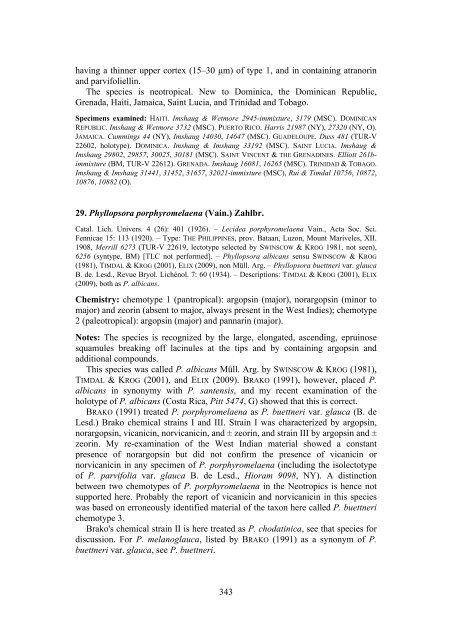A Lichenological Legacy – Festschrift Thomas H
A Lichenological Legacy – Festschrift Thomas H
A Lichenological Legacy – Festschrift Thomas H
You also want an ePaper? Increase the reach of your titles
YUMPU automatically turns print PDFs into web optimized ePapers that Google loves.
having a thinner upper cortex (15<strong>–</strong>30 μm) of type 1, and in containing atranorin<br />
and parvifoliellin.<br />
The species is neotropical. New to Dominica, the Dominican Republic,<br />
Grenada, Haiti, Jamaica, Saint Lucia, and Trinidad and Tobago.<br />
Specimens examined: HAITI. Imshaug & Wetmore 2945-immixture, 3179 (MSC). DOMINICAN<br />
REPUBLIC. Imshaug & Wetmore 3732 (MSC). PUERTO RICO. Harris 21987 (NY), 27320 (NY, O).<br />
JAMAICA. Cummings 44 (NY), Imshaug 14030, 14647 (MSC). GUADELOUPE. Duss 481 (TUR-V<br />
22602, holotype). DOMINICA. Imshaug & Imshaug 33192 (MSC). SAINT LUCIA. Imshaug &<br />
Imshaug 29802, 29857, 30025, 30181 (MSC). SAINT VINCENT & THE GRENADINES. Elliott 261bimmixture<br />
(BM, TUR-V 22612). GRENADA. Imshaug 16081, 16265 (MSC). TRINIDAD & TOBAGO.<br />
Imshaug & Imshaug 31441, 31452, 31657, 32021-immixture (MSC), Rui & Timdal 10756, 10872,<br />
10876, 10882 (O).<br />
29. Phyllopsora porphyromelaena (Vain.) Zahlbr.<br />
Catal. Lich. Univers. 4 (26): 401 (1926). <strong>–</strong> Lecidea porphyromelaena Vain., Acta Soc. Sci.<br />
Fennicae 15: 113 (1920). <strong>–</strong> Type: THE PHILIPPINES, prov. Bataan, Luzon, Mount Mariveles, XII.<br />
1908, Merrill 6273 (TUR-V 22619, lectotype selected by SWINSCOW & KROG 1981, not seen),<br />
6256 (syntype, BM) [TLC not performed]. <strong>–</strong> Phyllopsora albicans sensu SWINSCOW & KROG<br />
(1981), TIMDAL & KROG (2001), ELIX (2009), non Müll. Arg. <strong>–</strong> Phyllopsora buettneri var. glauca<br />
B. de. Lesd., Revue Bryol. Lichénol. 7: 60 (1934). <strong>–</strong> Descriptions: TIMDAL & KROG (2001), ELIX<br />
(2009), both as P. albicans.<br />
Chemistry: chemotype 1 (pantropical): argopsin (major), norargopsin (minor to<br />
major) and zeorin (absent to major, always present in the West Indies); chemotype<br />
2 (paleotropical): argopsin (major) and pannarin (major).<br />
Notes: The species is recognized by the large, elongated, ascending, epruinose<br />
squamules breaking off lacinules at the tips and by containing argopsin and<br />
additional compounds.<br />
This species was called P. albicans Müll. Arg. by SWINSCOW & KROG (1981),<br />
TIMDAL & KROG (2001), and ELIX (2009). BRAKO (1991), however, placed P.<br />
albicans in synonymy with P. santensis, and my recent examination of the<br />
holotype of P. albicans (Costa Rica, Pitt 5474, G) showed that this is correct.<br />
BRAKO (1991) treated P. porphyromelaena as P. buettneri var. glauca (B. de<br />
Lesd.) Brako chemical strains I and III. Strain I was characterized by argopsin,<br />
norargopsin, vicanicin, norvicanicin, and ± zeorin, and strain III by argopsin and ±<br />
zeorin. My re-examination of the West Indian material showed a constant<br />
presence of norargopsin but did not confirm the presence of vicanicin or<br />
norvicanicin in any specimen of P. porphyromelaena (including the isolectotype<br />
of P. parvifolia var. glauca B. de Lesd., Hioram 9098, NY). A distinction<br />
between two chemotypes of P. porphyromelaena in the Neotropics is hence not<br />
supported here. Probably the report of vicanicin and norvicanicin in this species<br />
was based on erroneously identified material of the taxon here called P. buettneri<br />
chemotype 3.<br />
Brako's chemical strain II is here treated as P. chodatinica, see that species for<br />
discussion. For P. melanoglauca, listed by BRAKO (1991) as a synonym of P.<br />
buettneri var. glauca, see P. buettneri.<br />
343<br />
eschweizerbart_xxx

















